MLB Hall of Fame: Breaking down the 2019 ballot


Voting to see who the next players inducted into the MLB Hall of Fame will be underway soon. Let us take a look at the ballot, and see which players are deserving of immortality.
It is one of the best times of year to be a baseball fan. The offseason is starting to get underway, with the Hot Stove heating up. Already, players like James Paxton have been moved, and the free agent courtships of the likes of Bryce Harper, Manny Machado, and Patrick Corbin promise to be fascinating.
Yet, of all the excitement that comes in the offseason, there is one moment that truly inspires debate and controversy like no other. The MLB Hall of Fame will be set to induct a new class, as the ballot has finalized. 35 candidates will learn their fate in the next few weeks, with some players hoping for that phone call that will lead to immortality, and others just hoping to get a vote or two.
But which of these players will get that call, leading to a place in the hallowed halls in Cooperstown? These are the best of the best, former All Stars, MVP winners, and Cy Young winners, all vying for votes. But only a select few, if any, will reach the required 75% threshold for induction.
Which players will get into the MLB Hall of Fame? Let us take a closer look at the ballot.
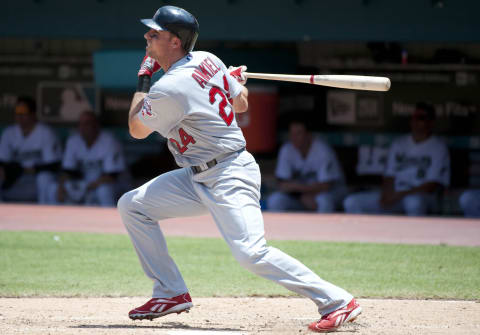
Rick Ankiel – 1st year on ballot
If one said early in his career that Rick Ankiel would be on the MLB Hall of Fame ballot, it would not be a surprise. The only surprise is how he got there.
Ankiel was a phenom for the Cardinals, an incredible fireballer who appeared to have a bright future ahead of himself on the mound. He finished second in the Rookie of the Year vote in 2000, a 20 year old who struck out ten batters per nine innings. Then, in the postseason, he developed the yips, firing the ball all over the place without any idea where it was going.
Yet, Ankiel was not done. Even as a pitcher, he was able to hit, producing a solid batting line and belting two homers in that rookie campaign. After attempting to return to the mound, he transformed into an outfielder, returning to the majors as a 27 year old. He went on to play seven more years in the majors, showing solid power and changing the narrative of his career.
Even though it would be a great story, Ankiel just does not have the resume to make the Hall of Fame. he never received votes for the Cy Young or the MVP, and was never an All Star. His .240/.302/.422 batting line, with 76 homers and 21 steals, is impressive for a former pitcher. But in the end, he was not a player worthy of induction.
Rick Ankiel may get a vote or two from a writer that wants to honor his perserverance. In the end, he was a great story, but he is not a Hall of Fame player.

Jason Bay – 1st year on ballot
Before Jason Bay joined the New York Mets, he was not quite a superstar, but in the next tier below.
Bay had been impressive with the Pirates and Red Sox. He was a three time All Star and the 2004 NL Rookie of the Year. Coming off one of the best seasons of his career, one where he finished seventh in the AL MVP vote and won a Silver Slugger, Bay looked like he would be a solid piece for the Mets future. Instead, he cratered, with injuries and a sudden loss of power due to his new ballpark destroying his career.
Overall, Bay had a respectable career. He produced a .266/.360/.481 batting line, hitting 222 homers and stealing 95 bases. He hit over 30 homers four times, and had a 20-20 season in 2005, when he hit 32 homers and stole 21 bases. Bay was a solid on base machine, the perfect player for the height of the MoneyBall Era.
The problem for Bay is that his sudden decline happened in the middle of his hypothetical prime. Early in his career, he appeared to be a burgeoning superstar, and came close to reaching those levels in Boston. Then, everything fell apart, with what seemed to be a special career falling short.
Jason Bay had his moments, and for a time, was one of the upcoming stars of the game. However, his career was not enough to earn induction into the MLB Hall of Fame.
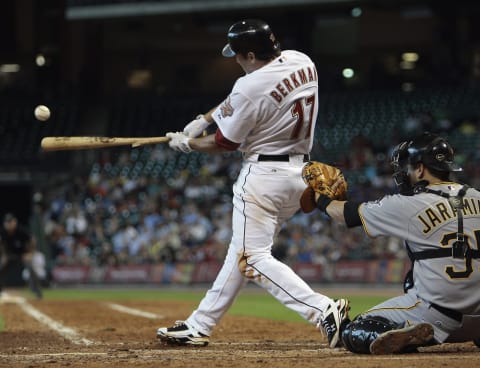
Lance Berkman – 1st year on ballot
Of all the players on the ballot, Lance Berkman may have the most underrated case for induction into the MLB Hall of Fame.
A solid player, Berkman was a key part of the Astros Killer B’s, helping the team to contention in the 1990s and into the 2000s. He was a six time All Star, finishing in the top ten of the MVP vote six times. Berkman posted a lifetime ..293/.406/.537 batting line, hitting 366 homers and 422 doubles while driving in 1234 runs. He was also a decent outfielder, especially early in his career when he was in left field.
While the numbers may not overwhelm, Berkman has a decent case. Based on the Hall of Fame monitor and standards created by Bill James, Berkman is just below the average player that has been inducted into Cooperstown. His seven year peak, and overall WAR, are just below that threshold as well. In fact, e is considered the 20th best left fielder in baseball history, ahead of the likes of Jim Rice and Lou Brock.
Even though Berkman has a respectable case for induction, it is mainly in a non-traditional way. His counting stats put him in the Hall of Very Good, alongside the likes of Don Mattingly and Minnie Minoso. He may well stay on the ballot for all ten years, but Berkman is not likely to be inducted at any point.
Lance Berkman had a solid, and relatively underrated, career. It just was not a Hall of Fame caliber one.
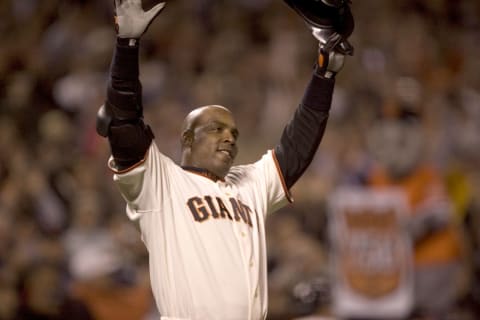
Barry Bonds – 7th year on ballot (56.4% in 2018)
We all know the numbers, and we all know the story.
There has been no one quite like Barry Bonds in baseball history. Not only is he one of the eight players to join the 300 homer/300 stolen base club, but he is the only player in the 400-400 and 500-500 clubs. Bonds was a 14 time All Star, a seven time MVP, an eight time Gold Glove winner, and a 12 time Sliver Slugger. He owns the single season and career home run records. Bonds walked over 1000 times more than he struck out. His overall .298/.444/.607 batting line, with 762 homers, 601 doubles, and 514 steals, are the stuff of video games.
Then there is the other side. Allegations of PED usage dogged the latter part of Bonds’ career. He was involved in the BALCO scandal, in which his personal trainer, Greg Anderson, was implicated. Bonds admitted to using substances called the cream and the clear, which he thought were flaxseed oil, and was later found guilty on a felony charge of obstructing justice. That conviction was later overturned on appeal, but the damage to his reputation had been done.
This desire to erase Bonds and his accomplishments from the game, and to ignore his greatness, is a disservice to the history of baseball. The Steroid Era had been celebrated, with the media and fans raving about Mark McGwire and Sammy Sosa chasing home run records, and the “chicks dig the longball” advertisements. In the end, the Steroid Era is no different than the Pre-integration Era, the Deadball Era, or any other era in the history of the game. It happened, and Bonds, regardless of his usage, was the greatest player in that time.
Barry Bonds deserves to be in the MLB Hall of Fame. It is long past time that he gets his due.
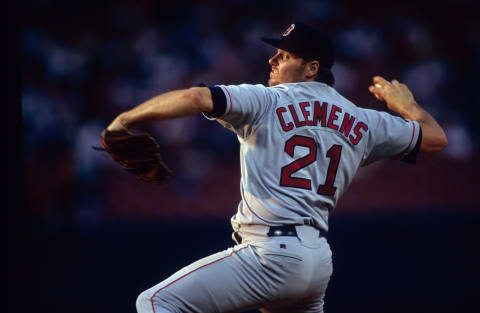
Roger Clemens – 7th year on ballot (57.3% in 2018)
Just like Barry Bonds, it is long overdue for Roger Clemens to be inducted into the MLB Hall of Fame.
Like his counterpart, Clemens had a career that was truly special. He was an 11 time All Star and a seven time Cy Young award winner. Clemens won the 1986 AL MVP award, and twice struck out 20 batters in a game. He won two pitching Triple Crowns, led the league in wins four times, strikeouts five times, and won seven ERA titles. Over his career, he produced a 354-184 record, along with a 3.12 ERA and a 1.173 WHiP, striking out 4672 batters in 4916.1 innings.
PED allegations also dog Clemens’ accomplishments. He was thought to be done after a mediocre four years in Boston, leaving the Red Sox to allow him to enter free agency after 1996. Instead, he suddenly became a star again, rising to prominence with the Blue Jays, and later, the Yankees and Astros. However, he was named in the Mitchell Report, and named by Jose Canseco and Jason Grimsley as a PED user, something he denied. Clemens was indicted on six counts of perjury regarding his testimony before Congress. Eventually, Clemens was acquitted on all charges.
The poster boy for PED usage amongst pitchers, Clemens has fallen under the same shadow as Bonds. Regardless of whether or not he was a PED user, Clemens was still one of the greatest pitchers of his era. His impressive resume, put together at a time when it is thought that half the league was juicing, is a testament to his ability and dominance.
Roger Clemens deserves to be in the Hall of Fame. It’s time this happens.
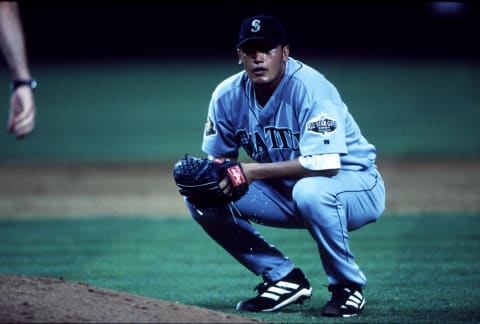
Freddy Garcia – 1st year on ballot
Freddy Garcia was once part of a trade that sent Randy Johnson to the Houston Astros. That is as close to the Hall of Fame as he will get.
That is not to say that Garcia was not a good pitcher in his own right. He was a solid piece of the Mariners rotation at the start of the 2000s, a two time All Star who finished third in the Cy Young vote in 2001. That year, he led the American League with a 3.05 ERA and 238.2 innings pitched, as he established himself as a workhorse in Seattle. Garcia had seven seasons with over 200 innings before he was beset by injuries.
Overall, Garcia had a 156-108 record over his 15 major league seasons, along with a 4.15 ERA and a 1.303 WHiP, striking out 1621 batters in his 2264 innings. Those numbers may not seem great, but Garcia did post a 107 ERA+, as the beginning part of his career was spent in the midst of the Steroid Era. Interestingly, he is still active, pitching in Mexico and in the Venezuelan Winter League despite not having pitched in the majors since 2013.
Garcia was a solid pitcher, a key piece in the success of the Mariners, and later, the White Sox, at the beginning part of his career. However, he lost his effectiveness after 2006, with injuries taking their toll. He had his moments on the diamond, but just was not the type of player that was worthy of the Hall of Fame.
Freddy Garcia was a solid pitcher who is still plying his trade down in Mexico. But that does not mean he will be immortalized in Cooperstown.
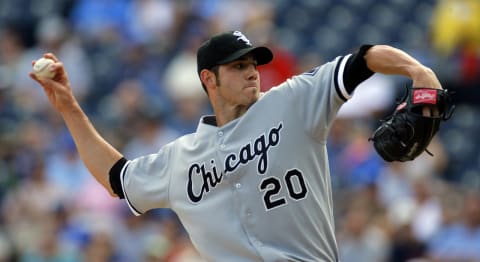
Jon Garland – 1st year on ballot
A solid pitcher throughout his career, Jon Garland was virtually the definition of a .500 pitcher, aside from two relatively decent years.
He found success in 2005 and 2006, his improvement coinciding with the White Sox own surge in the standings. Garland was an All Star in 2005, a surprise 18 game winner who finished sixth in the Cy Young vote. He won another 18 games in 2006, although with less success, before settling back in as a basically average back of the rotation arm.
During the course of his career, Garland posted a 136-125 record, along with a 4.35 ERA and a 1.387 WHiP. Never a strikeout pitcher, he struck out 1156 batters in his 2151.2 innings, issuing 723 walks. Garland was what he was – a back of the rotation starter who had two good seasons.
Being a steady arm who can generate outs and throw 200 or more innings a year can be a great career path. Garland, despite his modest numbers, was able to carve out a 13 year career before shoulder surgery in 2011 sapped his ability and essentially ended his career.
Jon Garland was a solid pitcher. He just was not a Hall of Fame caliber one.
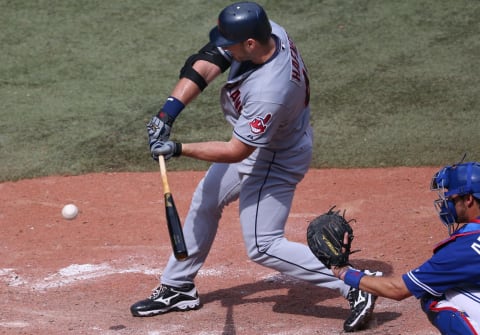
Travis Hafner – 1st year on ballot
When he was healthy, Travis Hafner was one of the most fearsome power hitters in the game. The problem was that he could not stay healthy.
Nicknamed Pronk and Donkey for his strength, Hafner was an impressive power hitting designated hitter for the Indians. Once he established himself as a major league player, he had four consecutive seasons where he hit over 20 homers, with a career high of 42 home runs in 2006. Hafner finished in the top ten of the MVP vote twice, an impressive total for a player who only had 72 career games in the field over his career.
That potentially solid career was cut short by injuries to his knees and back. The powerful slugger was a shadow of himself in the latter stage of his career, but he still produced decent numbers. Hafner had a .273/.376/.498 batting line, hitting 213 homers and 250 doubles. One has to wonder what those numbers could have been if his back and knees held out.
On the list of designated hitters who have not been inducted into the MLB Hall of Fame, we find the likes of Edgar Martinez (possibly changing this year), Harold Baines, Don Baylor, and Hal McRae, amongst others, have not been inducted. Hafner, while a productive hitter in the four years he was healthy, just did not have the type of career that measures up to those other players.
Travis Hafner was an excellent designated hitter for four years, and probably should have been an All Star in at least one of those seasons. He just was not healthy long enough to have a real case for the Hall.
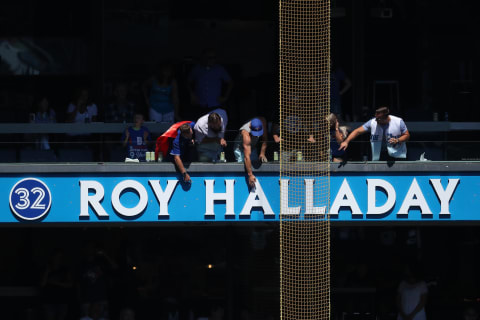
Roy Halladay – 1st year on ballot
This should have been a time to celebrate Roy Halladay’s career. Instead, it is a time for remembrance for a life lost far too soon.
A star for the Blue Jays and Phillies, Halladay was one of the best pitchers in the game in the 2000s. He had struggled early on, completely losing his ability to command his arsenal in 2000, leading to his being demoted all the way to the Florida State League in 2001. However, he rediscovered his form with that stint in the minors, going on to be a force at the major league level once again.
Halladay quickly established himself as an ace, becoming an eight time All Star and was a two time Cy Young winner, one of six players to win the award in both leagues. He fired the second no hitter in postseason history in his playoff debut in 2010, and became the fifth pitcher to throw two no hitters in a year. Understandably, he had impressive numbers over his career, posting a 203-105 record, along with a 3.38 ERA and a 1.178 WHiP. Over his 2749.1 innings, Halladay struck out 2117 batters with only 592 walks.
It seems likely that Halladay gets inducted into the Hall of Fame at some point. His overall production, and his early death, albeit by his recklessness, will certainly be factors in his case. He had crashed his plane into the ocean, after flying dangerously close to the water and performing abrupt climbing maneuvers. Alcohol, morphine, and other drugs were found in his system, and were likely contributing factors to his passing.
Roy Halladay should have a strong first year on the ballot. Whether or not that is enough to get him into the MLB Hall of Fame in his first year is more uncertainly. Nonetheless, he appears destined to be inducted in the future.
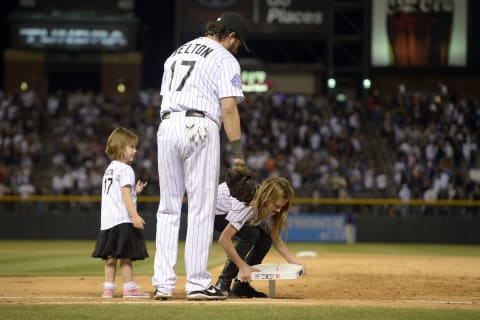
Todd Helton – 1st year on ballot
How much does Coors Field factor into the voting process for the MLB Hall of Fame? We will find out with Todd Helton.
Once the backup quarterback to Peyton Manning at the University of Tennessee, Helton found success on the diamond. He was a five time All Star and a four time Silver Slugger, winning the batting title in 2000. Helton had six seasons of 30 or more homers, and drove in over 100 runs five times. He was also excellent defensively, winning three Gold Glove awards, leading the league in runs saved at first four times, and is second all time with 106 runs saved.
Not only was he one of the best defensive first basemen in the history of the game, but his career numbers at the plate were impressive as well. Helton produced a .316/.414/.539 batting line, hitting 366 homers and 592 doubles. His .953 OPS is the 19th best mark in baseball history, showing that helton was a stellar all around player during his career.
The Hall of Fame monitor and Standards agree. While the average Hall of Famer has a 100 on the monitor score, Helton is in at 175. Likewise, he surpasses the average Hall of Famer in the standards rating, with his 59 above the average of 50. Helton ranks ahead of players like Hank Greenberg, George Sisler, and Harmon Killebrew in terms of WAR at first base. But, you know, Coors Field and the thin air inflating offensive totals….
Todd Helton would be a deserving Hall of Famer if he was inducted. Chances are, the stigma of Coors Field will work against him.

Andruw Jones – 2nd year on ballot (7.3% in 2018)
As solid as a hitter as Andruw Jones was early in his career, his case is best defined by his defensive ability.
For a time, Jones was one of the most dynamic players in the game. He announced his presence with authority, with a solid rookie campaign, and later became the youngest player in World Series history to homer. Jones would go on to be a five time All Star, hitting over 30 homers seven times in his career. He was also a brilliant defensive center fielder, winning ten Gold Glove awards.
Despite ballooning in size, and seeing his career fall off a cliff once he left the Braves, Jones still had respectable production. He had a .254/.337/.486 batting line, hitting 434 homers and 383 doubles, while stealing 152 bases. Most impressively, Jones saved 228 runs in center, the most in MLB history, and his total of 258 runs saves trails only Brooks Robinson. Jones is 52 runs ahead of Willie Mays in center, making him the greatest defensive outfielder by a wide margin.
Several players have been inducted into the MLB Hall of Fame for their defense. Players like Ozzie Smith, Bill Mazeroski, and Ray Schalk are Hall of Famers in large part because of their defensive ability. Jones is right there with any of the best defensive players ever to put on a uniform. That alone should give him a strong case for enshrinement.
Instead, Andruw Jones may be lucky to see 10% of the vote this year. His ability on the diamond, while superlative throughout the beginning part of his career, is overlooked by the way his time ended.
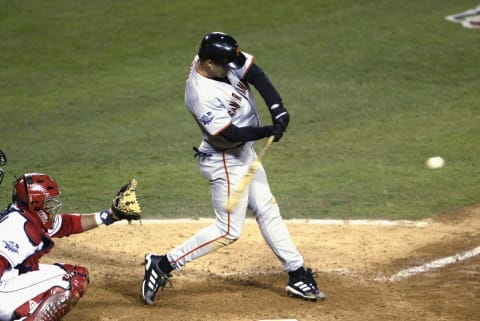
Jeff Kent – 6th year on ballot (14.5% in 2018)
Quite simply, Jeff Kent deserves better when it comes to the Hall of Fame vote.
Perhaps it is due to the late start he had in getting his career going, as Kent did not establish himself until after signing with the Giants when he was 29 years old. However, from that point, he was one of the best second basemen in the game, a power threat in the middle of the infield that did not really exist in the course of the game. Or, perhaps it is due to his dour personality, as Kent was not exactly beloved by the media nor in the clubhouse.
Yet, that does not take away from his accomplishments. Kent was a five time All Star and the 2000 NL MVP, while winning four Silver Sluggers. He hit 20 or more homers 12 times in his career, en route to a stellar .290/.356/.500 batting line, hitting 377 homers and 560 doubles. He was a solid run producer, driving in over 100 runs eight times, and finishing with 1518 career RBI.
The biggest problem with Kent’s candidacy may be the possible stain of PED usage. Although he never tested positive for PEDs in his career, Kent did not blossom into a star until joining the Giants and having Barry Bonds as a teammate. That stigma, whether or not it is accurate, has already kept Bonds out thus far. The same may be applied to Kent as well.
Jeff Kent should be inducted into the MLB Hall of Fame. However, he may never get the support needed for induction.
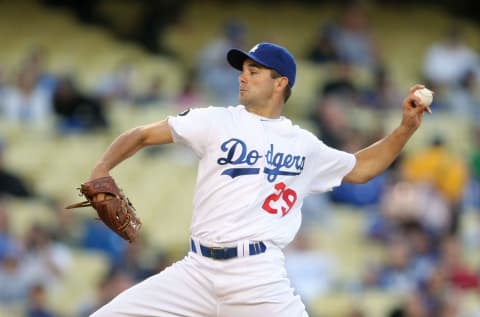
Ted Lilly – 1st year on ballot
Somehow, some way, Ted Lilly has found his way onto the Hall of Fame ballot.
That is not a knock on Lilly’s career. Indeed, he was a solid pitcher, winning double digit games for nine consecutive years. Lilly was an All Star twice, and was a solid middle of the rotation option for the A’s, Cubs, and Blue Jays. He pitched over 180 innings six times, and led the NL with 34 starts in 2008.
His career numbers were relatively solid. Lilly posted a respectable 130-113 record, along with a 4.14 ERA and a 1.255 WHiP. Over his 1982.2 innings, he struck out 1681 batters with 661 walks. While his ERA may not look that impressive, it was worth an ERA+ of 106, making him just above average for his time.
He ran into some legal trouble after his career. Lilly was indicted on three counts of felony insurance fraud, when he tried to insure a vehicle that was already damaged, then submitted an inflated bill to get the money. However, those issues have no really bearing on a Hall of Fame case that was already fairly weak to begin with.
Chances are, the best that Ted Lilly could hope for is a single vote on the Hall of Fame ballot. Even that might be more than he will get.
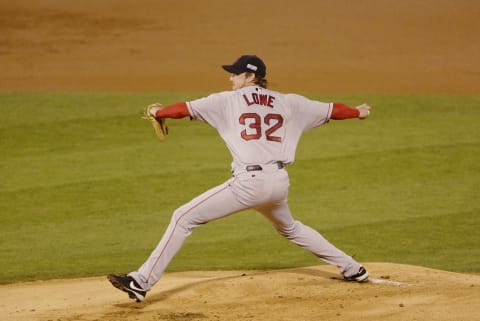
Derek Lowe – 1st year on ballot
Whatever the Red Sox needed from Derek Lowe, he was able to provide.
Stolen from the Seattle Mariners along with Jason Varitek for Heathcliff Slocum, Lowe filled virtually every spot in the Red Sox pitching staff. He was an All Star as a closer and as a starting pitcher, leading the league in saves in 2000. Back in the rotation in 2002, Lowe fired a no hitter against the Rays on April 27.
After leaving the Red Sox and moving on to the Dodgers and Braves, he remained a solid starter. Lowe posted a 176-157 record during his career, recording 86 saves. Over his 2671.1 innings, Lowe posted a 4.03 ERA and a 1.330 WHiP, striking out 1722 batters with only 794 walks. He was a solid, and occasionally stellar, pitcher over his career.
While Lowe was a steady innings eater as a starter, his career was not exactly the type that was overly impressive. He was a part of the Red Sox curse breaking team in 2004, although that was one of his worse seasons in the majors. While getting a championship in Boston could help the cause, his production just is not enough for induction.
Derek Lowe will likely receive a few votes on the ballot. But he is not a Hall of Fame caliber pitcher.
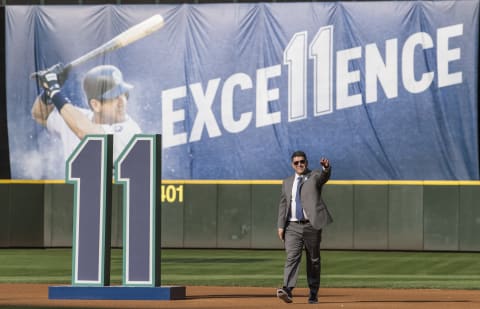
Edgar Martinez – 10th year on ballot (70.4% in 2018)
If Edgar Martinez played any position on the diamond, he would already in the MLB Hall of Fame. however, his status as one of the greatest designated hitters in the history of the game is hindering his candidacy.
There is no questioning his credentials. Martinez was a seven time All Star and a five time Silver Slugger, a truly professional hitter. He won two batting titles, and batted over .300 in ten of his 18 seasons. Martinez had a bit of pop as well, hitting over 20 homers eight times, and leading the league in doubles twice.
During his career, spent entirely in Seattle, Martinez produced an excellent .312/.418/.515 batting line, hitting 309 homers and 514 doubles. Considering he was not a regular with the Mariners until he was 27 years old, Martinez had some truly impressive numbers. Along with Ken Griffey Jr. he was one of the great hitters in team history.
At this point, it seems that Martinez is going to get the call of immortality. After hovering in the 20 to 30% range for six years, he has climbed the standings, coming in with 70.4% of the vote last year. He was just 20 votes shy of induction last year, and may get that final push to get enshrined in his final year on the ballot.
Edgar Martinez should have been in the Hall of Fame a long time ago. This year, he may finally become the first designated hitter to be inducted.
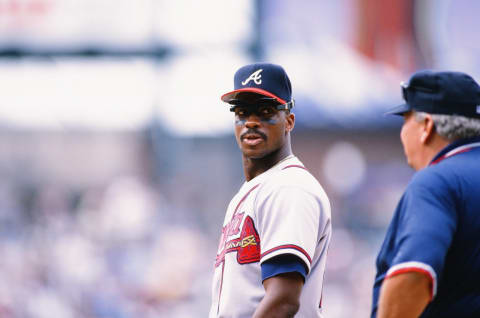
Fred McGriff – 10th year on ballot (23.2% in 2018)
One has to wonder what Fred McGriff’s Hall of Fame case would look like if he hit seven more homers.
He was one of the most consistent power hitters in his time, hitting 30 or more homers eight times, and leading the league twice. However, he never reached the 40 home run plateau, with his career best being 37 home runs set in 1993. While he was a league leading power hitter early in his career, once the Steroid Era began, his power was not nearly as impressive.
Yet, looking at the raw numbers, McGriff absolutely deserves consideration for the Hall of Fame. He produced a solid 284/.377/.509 batting line, belting 493 homers and driving in 1550 runs. McGriff had 2490 hits in his career as well, leaving him just short of two milestones that could have made a difference in the eyes of the voters.
Then again, he was often overlooked during most of his career. McGriff only made five All Star Games, and only made the MidSummer Classic once during a five year stretch where he averaged 35 homers and had a 155 OPS+. Given how overshadowed he was during his career, perhaps it is not that much of a surprise that he has never received more than 23.9% of the vote.
If Fred McGriff ever finds himself in the Hall of Fame, it will be through the Veteran’s Committee. However, he deserved better during his time on the ballot.
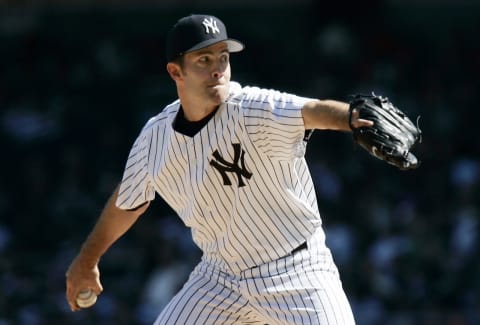
Mike Mussina – 6th year on ballot (63.5% in 2018)
It seems like, eventually, Mike Mussina will be enshrined in Cooperstown.
His is a case in remarkable consistency. While he only won 20 games once, with that coming in his final year, he won double digit games in all but one of his 18 seasons in the majors. During that time, he only had a losing record twice, with one of those coming in his rookie campaign in 1991 when he made only 12 starts.
Mussina had a very impressive career. He posted a 270-153 record, with a 3.68 ERA and a 1.192 WHiP. In his 3562.2 innings, Mussina struck out 2813 batters with only 785 walks. He was a five time All Star, and finished second in the Cy Young vote twice. Mussina was also brilliant defensively, winning seven Gold Glove awards during his career.
One has to wonder if Mussina would be in the Hall of Fame already if he stuck around for another year or two. He had one of the better final seasons of any player in baseball history, and ended his career just shy of the 300 win and 3000 strikeout plateaus. If he had pitched for one or two more years, Musinna may have already been inducted.
Chances are, Mike Mussina will eventually be a hall of Famer. It just might not happen this year.
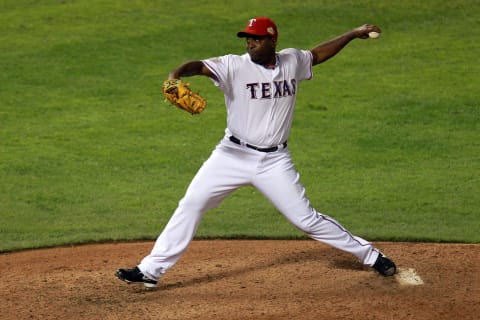
Darren Oliver – 1st year on ballot
Every year, there is some middle reliever who finds themselves on the MLB Hall of Fame ballot. This year, it is Darren Oliver’s turn.
Oliver was not always a reliever, spending eight of his 20 major league seasons as a starter. He struggled in that capacity, posting a 5.13 ERA and a 1.539 WHiP in his 229 career starts. However, he was a solid reliever, posting a 3.19 ERA and a 1.226 WHiP out of the bullpen, while bumping his K/9 rate from 5.2 to 7.5.
Overall, Oliver had a relatively solid career. He posted a 118-98 record, along with a 4.51 ERA and a 1.439 WHiP, striking out 1259 batters in his 1915.2 innings. Even though his ERA is not exactly impressive, it was still considered above average, worth a 104 ERA+. He was primarily used as a lefty specialist in his second career as a reliever, with only seven career saves.
Oliver managed to put together a decent career, earning a bit over $49 million during his time in the majors. He was the second player, following Nolan Ryan, to play for the four original expansion teams. Ryan also player with both Darren Oliver, and his father, Bob Oliver. So, there is an interesting bit of trivia about this Oliver’s career.
However, that is not enough to earn induction. In a few years time, the fact that Darren Oliver was on the ballot will just be another curious bit of trivia.
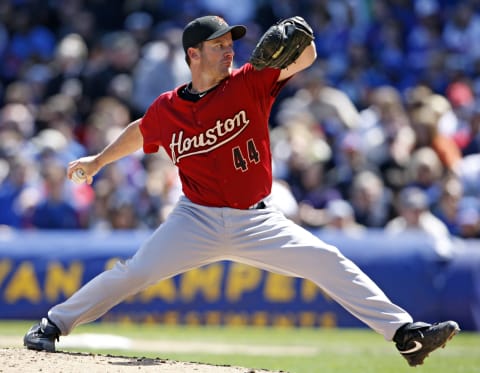
Roy Oswalt – 1st year on ballot
A key part of the Houston Astros rotation at the start of his career, Roy Oswalt appeared to be on a Hall of Fame trajectory until he faltered due to injuries.
Before being slowed down by two degenerative disks in his back, Oswalt was one of the best pitchers in the National League. He won the 2006 NL ERA title, and won 20 games twice. Despite his thin frame, as he was 6′ tall and weighed 190 pounds, he was a tremendous strikeout artist when healthy. Oswalt was also a workhorse in those early years, with seven seasons where he threw over 200 innings.
A three time All Star, and the MVP of the 2005 NLCS, Oswalt posted a 163-102 record lifetime record, with a 3.36 ERA and a 1.211 WHiP. In his 2245.1 innings, he struck out 1852 batters while issuing only 520 walks. He was also great at keeping the ball in the yard, allowing only 197 homers in his career.
In a lot of ways, Oswalt’s career is similar to that of Ron Guidry. Another undersized flamethrower, Guidry was great in the early part of his career until injuries got the best of him. Oswalt was an excellent pitcher until his back issues got the best of him in 2011 while he was just 33 years old, keeping him from being able to improve his overall numbers. Perhaps it is not a coincidence that Guidry ranks as the sixth most similar pitcher to Oswalt per Baseball Reference.
Roy Oswalt had appeared to be on a Hall of Fame path, but he was unable to remain healthy and fulfill that potential. He may stay on the ballot, but induction just will not happen.
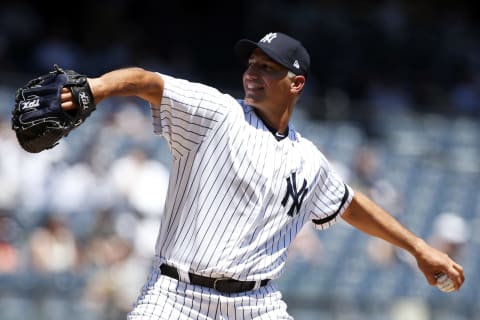
Andy Pettitte – 1st year on ballot
Of any first year player on the ballot, Andy Pettitte’s candidacy is the most fascinating.
Just a look at his resume would lead one to consider him a borderline Hall of Famer. He was only a three time All Star, but he was a key part of the Yankees dominance in their most recent Golden Age, winning five championships. Pettitte was remarkably consistent, winning 15 or more games eight times in his career. Overall, he posted a solid 256-153 record, with a 3.85 ERA and a 1.351 WHiP. While he was not a great strikeout pitcher, he did notch 2448 strikeouts against just 1031 walks in 3316 innings.
The biggest problem with his candidacy comes back to his PED usage. Pettitte admitted to using Human Growth Hormone after being named in the Mitchell Report, saying that he used it to recuperate from an elbow injury in 2002, and later admitted to further usage when coming back from a tendon injury in 2004.
Pettitte is one of the select few players who were popped for PED usage that had their guilt forgotten about. In those discussions about steroid or HGH users, his name never comes up, perhaps due to his admittance and subsequent apology. Yet, while Pettitte is forgiven in the court of public opinion, he may not be when it comes to his candidacy for the MLB Hall of Fame.
Andy Pettitte has a relatively solid case for enshrinement. His HGH usage, however, may say otherwise.
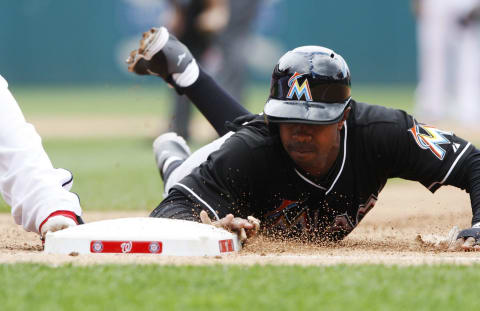
Juan Pierre – 1st year on ballot
During his prime, Juan Pierre was an exciting leadoff man.
While he never made an All Star team, Pierre’s impact on the game was noticeable. He earned MVP votes twice, finishing tenth in the voting in 2003 when the Marlins won their second championship. He led the league in steals three times, but was a bit of an adventure on the basepaths as well, leading in caught stealing seven times.
During the course of his career, Pierre produced a decent .295/.343/.361 batting line. He had almost no power, with only 18 homers in his 14 year career, but he legged out 255 doubles and 94 triples. His calling card was his ability to steal bases, as Pierre stole 614 bases, stealing over 50 bases five times. Those 614 steals rank 18th in major league history.
Pierre was a solid defensive outfield as well, using his speed to lead NL center fielders in putouts twice, and left fielders in putouts once. Yet, his speed was not enough to earn enshrinement into the Hall of Fame – he simply was not enough of a well rounded player to make that type of an impact on the game. Pierre used his skills, particularly his speed, to his advantage, but that was not enough.
Juan Pierre was a classic slap hitting speedster who played a key part on the Marlins second championship team. At least he will be fondly remembered in Miami.
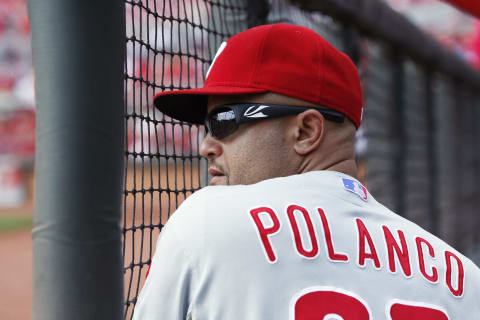
Placido Polanco – 1st year on ballot
It never seemed like Placido Polanco got his due as a player.
Perhaps this was because he never really had a set position, shuffling between second and third with occasional forays to short. Or, it may have been because he was overshadowed by other players on his teams. Yet, he was a professional hitter, an excellent batsman who had an incredible ability to put the ball into play.
Regardless of the position, Polanco excelled. He was a two time All Star, but won three Gold Gloves for his work at second and third. Polanco was the MVP of the 2006 ALCS, helping push the Tigers into the World Series. Overall, he produced a solid .297/.343/.397 batting line, hitting 348 doubles and 104 homers. In his 7887 plate appearances, Polanco only struck out 538 times.
An important part of several successful teams, Polanco was the perfect second hitter, his ability to make contact perfect for the hit and run or to move the runner over. He got on base at a respectable clip as well, helping to set the table for the sluggers behind him. Polanco may have been more valuable to a team than his statistics indicated.
Yet, that will not be enough to earn enshrinement in Cooperstown. Polanco was a solid player, but this ballot is as far as his candidacy will go.
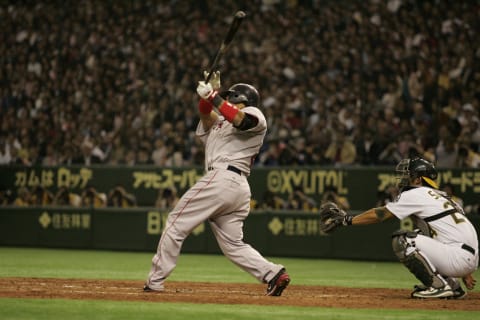
Manny Ramirez – 3rd year on ballot (22.0% in 2018)
it is probably a good think that Manny Ramirez could hit a baseball. One has to wonder what he would have done otherwise.
He was always an adventure. From disappearing at the start of an inning because he was using the bathroom in the Fenway scoreboard, to cutting off a Johnny Damon throw in the outfield, to getting into a fight with a clubhouse attendant, Manny was Manny. One had to take the good with the bad when it came to his time on the field.
When he was on, few players were as good with the bat as Ramirez. A 12 time All Star and nine time Silver Slugger, he produced a .312/.411/.585 batting line, hitting 555 homers and 547 doubles. One of the great run producers in the history of the game, Ramirez had 1831 RBI, 19th most in MLB history.
The problem with Ramirez is that he was suspended for PED usage twice. The first time came during his time with the Dodgers in 2009, and the second one, with the Rays in 2011, ended his major league career. Although he bounced through three different organizations in the minors, and even had a stint in the Chinese Professional Baseball League, Ramirez did not return to the majors after his “retirement” in the wake of his second PED suspension. He also was arrested for domestic assault, giving Ramirez the triumvirate of being a difficult figure in the locker room, PED suspensions, and domestic violence.
Based on the numbers, Manny Ramirez is a Hall of Famer. Based on his character, he is not. Right now, the character clause is winning out.
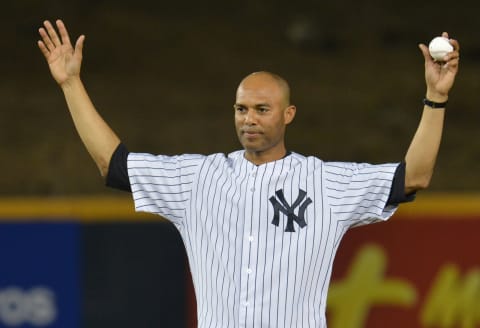
Mariano Rivera – 1st year on ballot
Putting a closer into the MLB Hall of Fame on the first ballot is a rare happening. But Mariano Rivera was no ordinary closer.
Armed with perhaps the most devastating cutter that the game has ever seen, Rivera dominated on the mound. He recorded 30 or more saves in 15 or his 19 years, his presence in the ninth a key part of the Yankees success. He was such a devastating reliever that, in 1996, he finished third in the Cy Young vote as a setup man.
Rivera’s career was without rival. A 13 time All Star, he was named the 1999 World Series MVP, the 2003 ALCS MVP, and the MVP of the 2013 All Star Game. Overall in his career, Rivera notched 652 saves, with a 2.21 ERA and a 1.000 WHiP. In his 1283.2 innings, he struck out 1173 batters with only 286 walks. He was even better in the postseason, posting a 0.70 ERA and a 0.759 WHiP with 42 saves in 141 career playoff innings.
While it is extremely unlikely that he will be the first unanimous Hall of Famer as some are speculating, there is little question that Rivera will be inducted. He was the greatest closer of all time, a dominant force that virtually guaranteed a victory when he came on with a lead.
Mariano Rivera will be making his next stop in Cooperstown. The only question is how much of the vote he will receive.
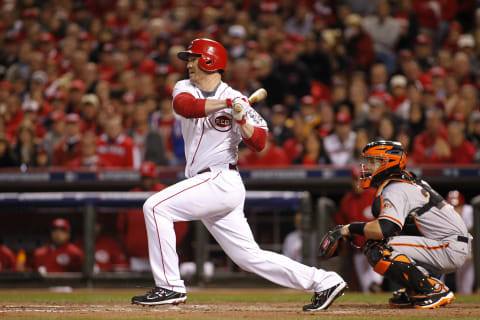
Scott Rolen – 2nd year on ballot (10.2% in 2018)
Last year, Scott Rolen was overshadowed by the presence of players like Chipper Jones and Jim Thome amongst first year candidates. This year, he should receive more support for his induction into the MLB Hall of Fame.
Rolen was an excellent all around player for the Cardinals and Phillies. A power hitting third baseman with speed, he was also an excellent defensive presence at the hot corner. An eight time Gold Glove winner, his 140 runs saved at third rank sixth all time, showing how valuable he was in the field.
Yet, Rolen was far more than an excellent defensive player. He was a seven time All Star and the 1996 NL Rookie of the Year, finishing as high as fourth in the 2006 NL MVP vote. Over the course of his career, he produced a .281/.364/.490 batting line, hitting 316 homers and 517 doubles. Rolen was a decent base stealer early in his career, swiping 118 bases in total. Add in his exceptional defense, and Rolen was one of the best third basemen that the game has seen.
Perhaps this year, Rolen will begin to climb up the voting ladder. His 10.2% of the vote from last year was laughingly low, especially given his resume. This year, he does not have to worry about as strong of a first year class, with Mariano Rivera likely to be the only inductee of the first year players. This gives Rolen a great opportunity to pick up some momentum for future years.
Scott Rolen may not be inducted this year, but he is a deserving candidate. Hopefully, his induction will be coming soon.
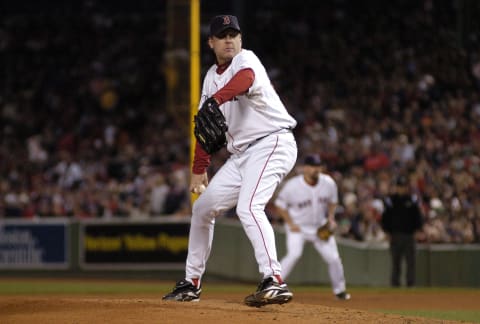
Curt Schilling – 7th year on ballot (51.2% in 2018)
Curt Schilling just cannot get out of his own way.
A late bloomer in his career, Schilling appeared as though he would eventually be inducted into the Hall of Fame. He was a borderline candidate, with a case that, statistically, would appear to be similar to those of Jack Morris and Andy Pettitte. Even if he was not voted in by the writers, his production would give him a strong case for the Veteran’s Committee.
Even though he did not find sustained success until he was 30 years old, Schilling put together a solid resume. A six time All Star and three time Cy Young runner up, he posted a 216-146 record, with a 3.46 ERA and a 1.137 WHiP. In his 3261 innings, Schilling struck out 3116 batters with only 711 walks. Add in his gutsy performance during the 2004 postseason, and the infamous Bloody Sock game, and Schilling has a solid case for enshrinement.
Then there is the personal side to Schilling. He started a video game company that ended up costing Rhode Island taxpayers $28.7 million. His controversial social media posts led to his being fired from ESPN. And, he has constantly railed against the media, claiming they are out to get him for his political views. That’s not exactly a way to get the writers to check that box next to his name.
He was not a slam dunk Hall of Famer based on his career numbers, but his views and conduct after his career may be the deciding factor. Chances are, Curt Schilling will not be inducted this year, and he may never get the votes he needs. But that will be the media’s fault as well.

Gary Sheffield – 5th year on ballot (11.1% in 2018)
Based on the numbers, Gary Sheffield has a strong case for the Hall of Fame. However, he cannot get any traction for his candidacy.
This may well be due to the nature of his career. He moved around a lot over his 22 year career, playing for eight different teams. Of those teams, the Marlins were the only franchise that he played more than four seasons with. Sheffield did not really have that career defining moment, nor that one team that he is readily associated with.
What Sheffield does have, however, is a strong statistical resume. During his career, he produced a stellar .292/.393/.514 batting line, hitting 509 homers and 467 doubles. He had eight seasons where he hit 30 or more homers, and another eight years with 100 or more RBI. Sheffield finished in the top three of the MVP vote three times, and was the runner up in the AL MVP vote in 2004.
However, Sheffield was not just his statistics. He had problems with his attitude, even admitting that he made errors in Milwaukee to force his way out of town. There have been suspicions about PED use during his career, although he never tested positive for any banned substances. However, that combination may be keeping Sheffield from even reaching 14% of the vote in his first four years on the ballot.
Gary Sheffield was an excellent player. However, his attitude problems and lack of a defining moment have left him on the outside looking in.
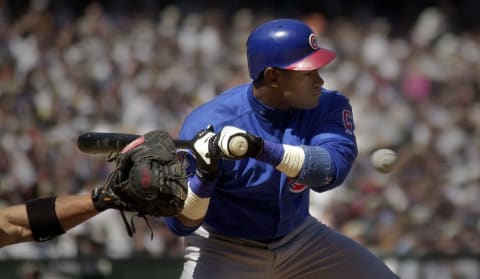
Sammy Sosa – 7th year on ballot (7.8% in 2018)
There was a time when Sammy Sosa was one of the more celebrated players in baseball. Those days are long gone at this point.
Back in 1998, MLB was still suffering the aftershocks of the disastrous Player’s Strike, which caused he cancellation of the World Series and effectively destroyed the Montreal Expos. Then, Sosa and Mark McGwire engaged in a chase for Roger Maris‘ home run record, captivating the nation and bringing baseball back to the forefront. The lovable Sosa was celebrated, credited with helping to save the game with his power and personality.
His overall numbers reflect his excellent run of success. A seven time All Star and six time Silver Slugger, Sosa was the 1998 NL MVP, beating out McGwire in the vote. He produced a .273/.344/.534 batting line, belting 609 homers and stealing 234 bases. He remains the only player ever to hit 60 or more homers in three seasons, and the only player to hit 60 or more homers and not lead the league in that category in that season.
However, Sosa’s time in the game ended on a sour note. He essentially walked out on the Cubs, angering his teammates who destroyed his locker. Sosa was also discovered to have used a corked bat, which, along with suspicions regarding PED use, have left Sosa barely hanging on the ballot.
Sammy Sosa may have helped to save baseball twenty years ago, but those days have long passed by.
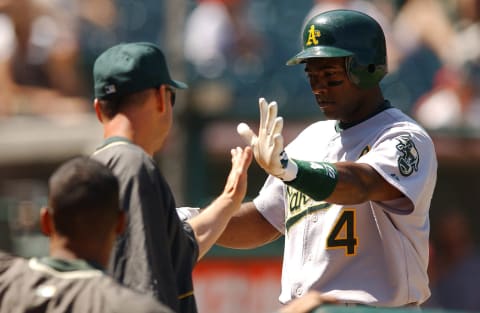
Miguel Tejeda – 1st year on ballot
Based on his resume, Miguel Tejeda had a chance for serious consideration for the MLB Hall of Fame. Instead, his actions have all but eliminated that possibility.
Based on the numbers, Tejeda deserves a long look. He was a six time All Star and a two time Silver Slugger, taking home the 2002 AL MVP award. A solid power hitting shortstop, he posted a .285/.336/.456 batting line, hitting 307 homers and 468 doubles. Tejeda led the league in doubles twice, and had four seasons of 30 or more homers.
The problem is, the picture for Tejeda goes beyond the numbers. He was first implicated in PEDs when Rafael Palmeiro tested positive for steroids, a positive test that he blamed on a shot he got from Tejeda. He later pled guilty to lying to Congress about his PED usage, and was given a fine, probation, and ordered to serve community service.
That is not the end of Tejeda’s issues. He was handed a 101 game suspension for the usage of amphetamines, the second time he had tested positive for the substance. Previously, he had an exemption for his prescription, but neglected to renew it. Tejeda also admitted to being two years older than previously thought, his birthday switching from 1976 to 1974.
All told, Miguel Tejeda left behind a mixed legacy, one that will not help his cause as he appears on the ballot for the first, and possibly only time.
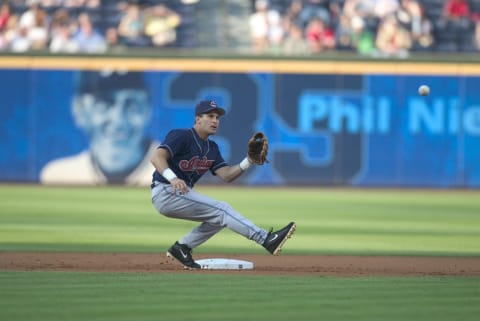
Omar Vizquel – 2nd year on ballot (37.0% in 2018)
Typically, when one thinks of Omar Vizquel, one remembers his incredible defense at short. Yet, he made himself far more than a defensive stalwart.
Vizquel was one of the best defensive shortstops that the game has ever seen. He won 11 Gold Glove awards, taking home the award for nine consecutive years from 1993 through 2001. Vizquel led the league in fielding percentage at short six times, and his .985 fielding percentage is second in major league history. He also saved 130 runs at short, the fifth best mark in the history of the game.
After struggling with the bat early in his career, Vizquel worked to make himself a productive hitter. He ended up posting a .272/.336/.352 batting line, stealing 404 bases and hitting 456 doubles. Vizquel also came tantalizingly close to the 3000 hit club, finishing his career with 2877 hits.
While his ability to make himself useful at the plate was impressive, he will not be inducted for his offense. Instead, he would be another player like Ozzie Smith and Bill Mazeroski, a solid enough hitter who dazzled with the glove. His ability to flash the leather may prove to be his ticket to Cooperstown.
It may not happen this year, but Omar Vizquel should eventually find his way into the MLB Hall of Fame. He had a great start towards getting the votes he needs.

Billy Wagner – 4th year on ballot (11.1% in 2018)
One of the best closers in the game, Billy Wagner was overlooked during his career, and during his time on the ballot.
During the regular season, he was one of the best relievers of his time. Wagner was a seven time All Star, saving 30 or more games nine times. Overall, he posted a lifetime 2.31 ERA and a 0.998 WHiP, notching 422 saves. In his 903 innings, Wagner struck out 1196 batters while issuing only 300 walks. Those numbers are right there with the likes of Mariano Rivera and Trevor Hoffman.
Unlike Rivera, Wagner did not have that same success in the postseason. In his 14 playoff games, he recorded only three saves, all of which came in 2006. He had a 10.03 ERA and a 1.971 WHiP in his 11.2 playoff innings, as he just could not find a way to get the opposition out.
Coupled with his postseason struggles, Wagner never led the league in saves. While he finished in the top three three times, he never was able to get those saves needed to move to the top of the leaderboard. Even though that should not matter, given his dominance in other areas, it is hard enough to get a closer into the Hall of Fame, let along one with those postseason struggles and lack of league leadership in any of the counting stats.
Billy Wagner deserves a look for the Hall of Fame. However, he has not gotten the attention his candidacy deserves.
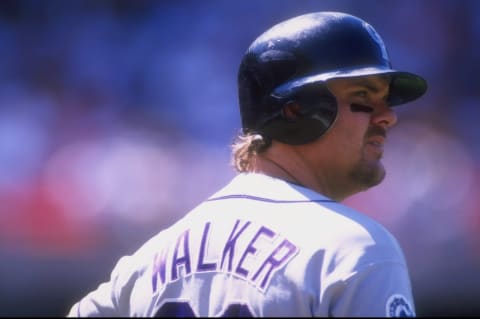
Larry Walker – 9th year on ballot (34.1% in 2018)
Let’s bring back a statistic from last year’s Hall of Fame ballot breakdown when it comes to Larry Walker.
We will take a look at a five year prime for Walker and another player, Player X. Walker, in that time frame, posted a .357/.445/.658 batting line, with 156 homers and 174 doubles. Meanwhile, Player X, over his five year prime, posted a .362/.508/.658 batting line, with 168 homers and 188 doubles. Who is Player X? None other than Ted Williams.
While this is not to say that Walker is Ted Williams, it just goes to show how underappreciated he was during his career. He produced a lifetime .313/.400/.565 batting line, his 141 OPS+ equal to the likes of Chipper Jones and David Ortiz. Walker hit 383 homers, 471 doubles, and stole 230 bases. He was a five time All Star, seven time Gold Glove winner, won three batting titles, and was the 1997 NL MVP.
Walker was certainly appreciated by the fans and the writers during his career. Yet, now that his playing days are over, he seems destined to fall off the ballot without getting enough credit for his excellent career. Perhaps this is the Coors Field stigma rearing its head, but Walker was a great hitter regardless of where he played.
Larry Walker was one of the best outfielders of his time. Perhaps, one day, he will be included in the game’s immortals.
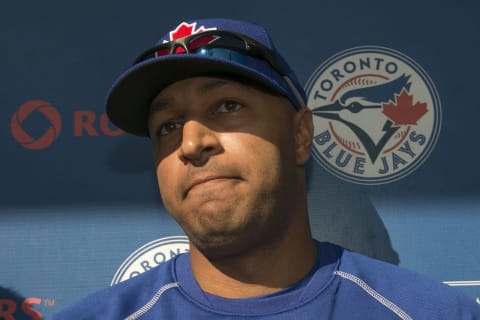
Vernon Wells – 1st year on ballot
A solid player in the early part of his career, Vernon Wells signed a long term extension with the Blue Jays, and quickly became a disaster.
That early part of his career was outstanding. Wells was a three time All Star and a three time Gold Glove winner, an excellent outfielder who the Blue Jays had seemingly locked up for his prime years. Indeed, his overall numbers, a .270/.319/.459 batting line with 270 homers and 379 doubles. Wells stole 109 bases as well, showing decent speed throughout his career.
Yet, as strong as his overall production was, Wells career fell off once he signed that extension. Although he did have a couple of solid years thereafter, even making an All Star team, he was never the same player. Wells was sent to the Angels essentially as salary relief, then moved on to the Yankees. When New York released him, his career was over, even though he was only 34 years old.
At one point, Wells looked like a possible candidate for the Hall of Fame. He had a strong beginning to his career, as the former first round pick rapidly rose through the minors to become an instant star in Toronto. Instead, his career fell apart, leaving him with an early end to his playing days, and on the outside looking in.
Vernon Wells made the MLB Hall of Fame ballot. However, that is as far as his candidacy is going.
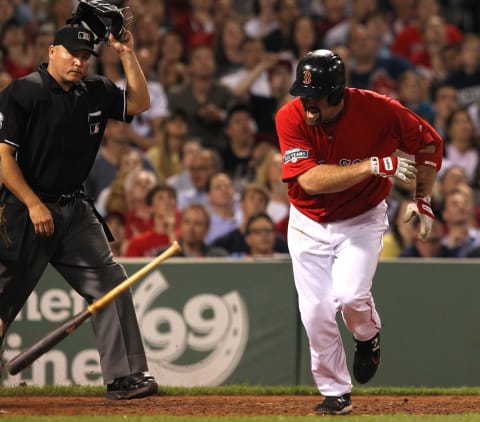
Kevin Youkilis – 1st year on ballot
Kevin Youkilis had one of the best nicknames in the history of the game, as he was called The Greek God of Walks. That excellent batting eye helped him become a key part of the Red Sox World Series winning teams at the beginning part of the decade.
He was already well known before he had his first full season in the majors in 2006. His unique nickname, as well as his prominent place in MoneyBall, made him a better known commodity than most minor league players. He certainly had some major expectations to live up to.
For the most part, Youkilis did just that. He quickly became a fan favorite in Boston, with cries of “YOOOOOOOUK!!!” echoing from the stands. Youkilis proved to be a solid player, a three time All Star who won a Gold Glove at third and twice finished in the top ten of the MVP vote. His lifetime .281/.382/.478 batting line, with 254 doubles and 150 homers, helped him live up to those expectations.
Yet, Youkilis had a very short prime. He was a solid player when healthy, but those injury issues took their toll. Youkilis was traded to the White Sox in the midst of the Red Sox disastrous 2012 campaign, and then signed with the Yankees the following year. Hoping to revive his career, he went to Japan for 2014, but the injury issues followed him overseas, leading to his retirement after just a decade in the majors.
A solid player, Kevin Youkilis earned his place as a fan favorite in Boston. Nonetheless, he has not earned a place in Cooperstown.
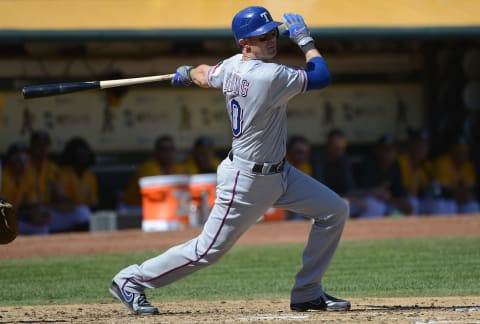
Michael Young – 1st year on ballot
One of the greatest players in Rangers history, Michael Young has an intriguing case for the MLB Hall of Fame.
More from Call to the Pen
- Philadelphia Phillies, ready for a stretch run, bomb St. Louis Cardinals
- Philadelphia Phillies: The 4 players on the franchise’s Mount Rushmore
- Boston Red Sox fans should be upset over Mookie Betts’ comment
- Analyzing the Boston Red Sox trade for Dave Henderson and Spike Owen
- 2023 MLB postseason likely to have a strange look without Yankees, Red Sox, Cardinals
A valuable piece for Texas, Young moved all around the diamond. He spent primarily time at second, third, and short, with over 400 games at each position. While he was not exactly a great defensive player, despite winning a Gold Glove at short, Young was able to make those plays he could get to, which allowed the Rangers to keep his bat in the lineup.
That bat proved to be a formidable weapon. Young was a seven time All Star, winning the 2005 batting title. Young had a lifetime .300/.346/.441 batting line, hitting 440 doubles and 185 homers. He had six seasons with over 200 hits, leading the AL twice.
All in all, Young was a solid, versatile piece for the Rangers. As they were in the midst of the run of consecutive World Series appearances, he was a key part of the lineup, helping bring the Rangers so very close to a championship in 2011. He played one more year, split between the Phillies and the Dodgers, before retiring at the end of the 2013 campaign, despite interest from several teams that wanted to sign him.
Next. Top prospects improving their value. dark
Michael Young was a solid player for the Rangers, with a decent enough case for the MLB Hall of Fame. Yet, as strong as his numbers may be, he did not play long enough to warrant serious consideration.